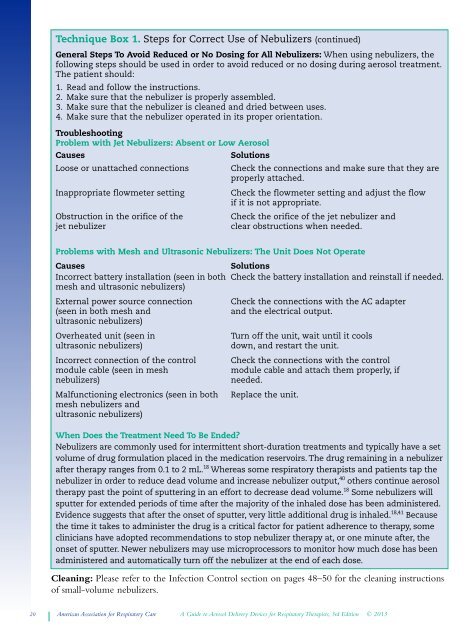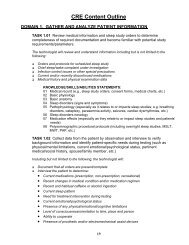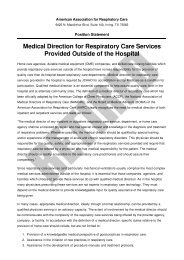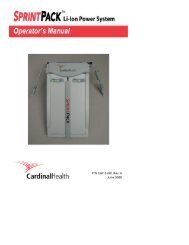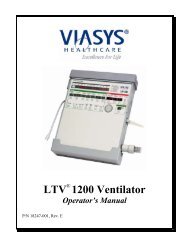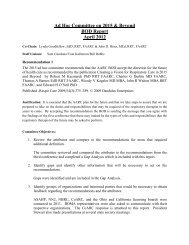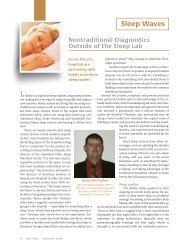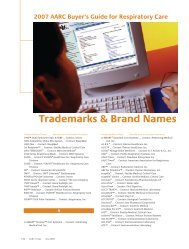Aerosol Guide - AARC.org
Aerosol Guide - AARC.org
Aerosol Guide - AARC.org
Create successful ePaper yourself
Turn your PDF publications into a flip-book with our unique Google optimized e-Paper software.
Technique Box 1. Steps for Correct Use of Nebulizers (continued)<br />
General Steps To Avoid Reduced or No Dosing for All Nebulizers: When using nebulizers, the<br />
following steps should be used in order to avoid reduced or no dosing during aerosol treatment.<br />
The patient should:<br />
1. Read and follow the instructions.<br />
2. Make sure that the nebulizer is properly assembled.<br />
3. Make sure that the nebulizer is cleaned and dried between uses.<br />
4. Make sure that the nebulizer operated in its proper orientation.<br />
Troubleshooting<br />
Problem with Jet Nebulizers: Absent or Low <strong>Aerosol</strong><br />
Causes<br />
Solutions<br />
Loose or unattached connections<br />
Check the connections and make sure that they are<br />
properly attached.<br />
Inappropriate flowmeter setting<br />
Check the flowmeter setting and adjust the flow<br />
if it is not appropriate.<br />
Obstruction in the orifice of the<br />
Check the orifice of the jet nebulizer and<br />
jet nebulizer<br />
clear obstructions when needed.<br />
Problems with Mesh and Ultrasonic Nebulizers: The Unit Does Not Operate<br />
Causes<br />
Solutions<br />
Incorrect battery installation (seen in both Check the battery installation and reinstall if needed.<br />
mesh and ultrasonic nebulizers)<br />
External power source connection Check the connections with the AC adapter<br />
(seen in both mesh and<br />
and the electrical output.<br />
ultrasonic nebulizers)<br />
Overheated unit (seen in<br />
Turn off the unit, wait until it cools<br />
ultrasonic nebulizers)<br />
down, and restart the unit.<br />
Incorrect connection of the control Check the connections with the control<br />
module cable (seen in mesh<br />
module cable and attach them properly, if<br />
nebulizers)<br />
needed.<br />
Malfunctioning electronics (seen in both Replace the unit.<br />
mesh nebulizers and<br />
ultrasonic nebulizers)<br />
When Does the Treatment Need To Be Ended<br />
Nebulizers are commonly used for intermittent short-duration treatments and typically have a set<br />
volume of drug formulation placed in the medication reservoirs. The drug remaining in a nebulizer<br />
after therapy ranges from 0.1 to 2 mL. 18 Whereas some respiratory therapists and patients tap the<br />
nebulizer in order to reduce dead volume and increase nebulizer output, 40 others continue aerosol<br />
therapy past the point of sputtering in an effort to decrease dead volume. 18 Some nebulizers will<br />
sputter for extended periods of time after the majority of the inhaled dose has been administered.<br />
Evidence suggests that after the onset of sputter, very little additional drug is inhaled. 18,41 Because<br />
the time it takes to administer the drug is a critical factor for patient adherence to therapy, some<br />
clinicians have adopted recommendations to stop nebulizer therapy at, or one minute after, the<br />
onset of sputter. Newer nebulizers may use microprocessors to monitor how much dose has been<br />
administered and automatically turn off the nebulizer at the end of each dose.<br />
Cleaning: Please refer to the Infection Control section on pages 48–50 for the cleaning instructions<br />
of small-volume nebulizers.<br />
20 American Association for Respiratory Care A <strong>Guide</strong> to <strong>Aerosol</strong> Delivery Devices for Respiratory Therapists, 3rd Edition © 2013


